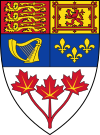Portal:Heraldry
Welcome to the Heraldry and Vexillology Portal!


Vexillology (from the Latin vexillum, a flag or banner) is the scholarly study of flags, including the creation and development of a body of knowledge about flags of all types, their forms and functions, and of scientific theories and principles based on that knowledge. Flags were originally used to assist military coordination on the battlefield, and have evolved into a general tool for signalling and identification, particularly identification of countries.
Heraldry encompasses all of the duties of a herald, including the science and art of designing, displaying, describing and recording coats of arms and badges, as well as the formal ceremonies and laws that regulate the use and inheritance of arms. The origins of heraldry lie in the medieval need to distinguish participants in battles or jousts, whose faces were hidden by steel helmets.
Selected biography

William Camden (May 2, 1551–November 9, 1623) was an English antiquarian and historian. He wrote Britannia, the first topographical survey of the island of Great Britain, and Annales, the first detailed historical account of the reign of Elizabeth I of England. In 1597 he was appointed Clarenceux King of Arms to facilitate his research, the post carrying a salary, and the College of Arms at the time being a centre of antiquarian studies. The appointment, however, roused the jealousy of the herald Ralph Brooke, who in retaliation published an attack on Britannia, charging Camden with inaccuracy and plagiarism. Camden successfully defended himself against the charges in subsequent editions of the work. (more...)
Selected flag

The Cubs Win Flag is a victory flag that is flown at Wrigley Field after every Chicago Cubs home win. The flag is variously referred to by approximately a dozen names, combining; either Cubs or Chicago Cubs; Win, W, White, White W, or W Win; and flag, banner or banner flag. It has become an important symbol for fans that one retailer describes as a fan banner instead of flag, or banner flag. In addition, days when the win flag is flown are known as "White Flag Days". The tradition of flying a win or loss flag over the stadium began soon after the construction of the scoreboard in 1937.
The flag has used two different color schemes with the letter "W" on a solid background, and there is a loss indicator flag with a letter "L". Additionally, the flags have been complemented by different color schemes of indicator lights. The flag has become a very symbolic emblem for devout Cubs fans. Some retailers sell slightly different versions that also have the Cubs logo at the bottom. (more...)
Selected coat of arms

The Royal Coat of Arms of Canada (known formally as the Arms of His/Her Majesty in Right of Canada) is, since 1921, the official coat of arms of the Canadian monarch, and thus also of Canada. It is closely modelled after the royal coat of arms of the United Kingdom with distinctive Canadian elements replacing or added to those derived from the British.
The maple leaves in the shield, blazoned "proper", were originally drawn vert (green) but were redrawn gules (red) in 1957. A circlet of the Order of Canada was added to the arms for limited use in 1987. The shield design forms the Royal Standard of Canada, and the shield is found on the Canadian Red Ensign. The Flag of the Governor General of Canada, which formerly used the shield over the Union Jack, now uses the crest of the arms on a blue field. (more...)
Selected picture
Created in 1936, after the restoration of the monarchy, the Coat of arms of the Kingdom of Greece was used until 1967, when King Constantine II was exiled, and then nominally until 1973 when the kingdom was replaced by the Third Hellenic Republic. The arms remains in use by the former Greek Royal Family.
Did you know...
- ...that Johan Teterisa was sentenced to life in prison for waving the banned secessionist flag (pictured) of the so-called Republic of the South Moluccas in front of Indonesian President Susilo Bambang Yudhoyono during a nonviolent protest?
- ...that Charles St Clair, 17th Lord Sinclair was both York Herald and a Scottish Peer, so he could attend the State Opening of Parliament in either capacity?
- ...that the cross in the coat of arms of Colchester represents the True Cross, as discovered by Saint Helena of Constantinople, the patron saint?
- ...that the flag of New Mexico is designed after the Zia tribe's symbol?
- ...that educator Anna Essinger, ordered to fly the swastika on Hitler's birthday in 1933, planned a day-long outing for her school, leaving the flag to fly over an empty building?
Related portals
|
|
|
Heraldry Web resources
Authorities
- Belgium - The Council of Nobility, Flemish Heraldic Council and Council of Heraldry and Vexillology of the French Community
- Canada - Canadian Heraldic Authority and see also Public Register of Arms, Flags and Badges
- England, Wales, and Northern Ireland - The College of Arms
- Ireland - The Office of the Chief Herald of Ireland
- Netherlands - High Council of Nobility
- Portugal - Instituto da Nobreza Portuguesa
- Scotland - The Court of the Lord Lyon
- South Africa - South African Bureau of Heraldry
- Sweden - National Board of Heraldry, The National Archive
- United States Army - The United States Army Institute of Heraldry
Societies
- Greek Heraldry Society
- The Academy of Heraldic Science Czech republic
- The American College of Heraldry
- The American Heraldry Society
- The Augustan Society
- The Australian Heraldry Society Inc.
- Bulgarian Heraldry and Vexillology Society
- The Center for Research of Orthodox Monarchism
- Cambridge University Heraldic and Genealogical Society
- Chiltern Heraldry Group
- The College of Dracology
- Croatian Heraldic and Vexillologic Association
- The Finnish Heraldic Society
- Fryske Rie foar Heraldyk
- Hellenic Armigers Society
- Guild of Heraldic Artists
- Genealogical Society of Ireland
- Heraldry Research Institute (Japan)
- The Heraldry Society
- The Heraldry Society of Africa
- The Heraldry Society of New Zealand Inc.
- The Heraldry Society of Scotland
- The Heraldry Society of Southern Africa
- The Institute of Heraldic and Genealogical Studies
- The International Association of Amateur Heralds
- Italian Center of Vexillological Studies
- Lancashire Heraldry Group
- Macedonian Heraldry Society
- New England Historic Genealogical Society Committee on Heraldry
- Norwegian Heraldry Society
- Oxford University Heraldry Society
- Polish Heraldry Society
- Polish Nobility Confederation
- Real Academia Matritense de Heráldica y Genealogía - Royal Academy of Heraldry and Genealogy of Madrid
- Romanian Institute for Genealogy and Heraldry
- The Royal Heraldry Society of Canada
- The Russian College of HeraldryThe Russian College of Heraldry
- Serbian Heraldic Society
- Societas Heraldica Scandinavica
- Societas Heraldica Slovenica
- Swedish Heraldic Society
- Ukrainian Heraldry Society
- Royal Association Genealogical and Heraldic Office of Belgium
Vexillology
Software
- Coat of Arms Visual Designer web-based program
- Puncher Heraldry Program
- Blazonry Server - pyBlazon
- DrawShield - creates SVG shield or arms image from blazon
- CoaMaker - web-based tool
- Blazon95 and BLAZONS! 2000, older Windows applications
Texts
- Heraldry, historical and popular : with seven hundred illustrations (1863)
- A Complete Guide to Heraldry (1909)
Other
Wikimedia
The following Wikimedia Foundation sister projects provide more on this subject:
-
Commons
Free media repository -
Wikibooks
Free textbooks and manuals -
Wikidata
Free knowledge base -
Wikinews
Free-content news -
Wikiquote
Collection of quotations -
Wikisource
Free-content library -
Wikispecies
Directory of species -
Wikiversity
Free learning tools -
Wikivoyage
Free travel guide -
Wiktionary
Dictionary and thesaurus













